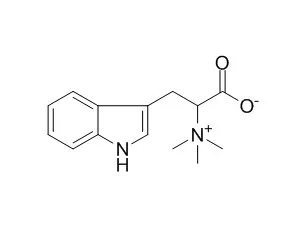| Kinase Assay: |
| Biochem Biophys Res Commun. 2002 Jun 14;294(3):553-9. | | A fungal auxin antagonist, hypaphorine prevents the indole-3-acetic acid-dependent irreversible inactivation of horseradish peroxidase: inhibition of Compound III-mediated formation of P-670.[Pubmed: 12056802] | Hypaphorine, an indolic alkaloid from an ectomycorrhizal fungus is a putative antagonist of indole-3-acetic acid (IAA) known to inhibit the effect of IAA in growing roots of Eucalyptus seedling. Previously we have used horseradish peroxidase-C (HRP) as a sensitive reporter of IAA-binding to the IAA-binding domain, and reported that Hypaphorine specifically inhibits the HRP-catalyzed superoxide generation coupled to oxidation of IAA [Kawano et al., Biochem. Biophys. Res. Commun. 288]. Since binding of IAA to the auxin-binding domain is the key step required for IAA oxidation by HRP, it was assumed that the inhibitory effect of Hypaphorine is due to its competitive binding to the auxin-binding domain in HRP.
METHODS AND RESULTS:
Here, we obtained further evidence in support of our assumption that Hypaphorine specifically inhibits binding of IAA to HRP. In this study, HRP arrested at the temporal inactive form known as Compound III was used as a sensitive indicator for binding of IAA to HRP. Addition of IAA to the preformed Compound III resulted in rapid decreases in absorption maxima at 415, 545, and 578 nm characteristic to Compound III, and in turn a rapid increase in absorption maximum at 670 nm representing the formation of P-670, the irreversibly inactivated form of hemoproteins, was induced. In contrast, the IAA-dependent irreversible inactivation of HRP was inhibited in the presence of Hypaphorine. In addition, the mode of interaction between IAA and Hypaphorine was determined to be competitive inhibition, further confirming that Hypaphorine is an IAA antagonist which specifically compete with IAA in binding to the IAA-binding site in plant peroxidases. |
|
| Structure Identification: |
| Planta. 2003 Dec;218(2):217-25. | | Hypaphorine, an indole-3-acetic acid antagonist delivered by the ectomycorrhizal fungus Pisolithus tinctorius, induces reorganisation of actin and the microtubule cytoskeleton in Eucalyptus globulus ssp bicostata root hairs.[Pubmed: 14504925] | Hypaphorine, an indole alkaloid from the ectomycorrhizal fungus Pisolithus tinctorius Coker & Couch., counteracts indole-3-acetic acid (IAA) activity and controls the rate of root hair elongation in Eucalyptus globulus ssp. bicostata.
METHODS AND RESULTS:
The present investigation shows that Hypaphorine changes cytoskeletal organisation in elongating root hairs of the host. In the Hypaphorine-treated root hairs no actin cap was distinguished. The fine actin filaments occurring in the subapical region were replaced by a few thick actin filament bundles that extended from the subapical region toward the root hair tip. In the Hypaphorine-treated hairs the total number of actin filament bundles along most of the root hair length was significantly reduced, presumably due to aggregation of pre-existing actin filaments. The first signs of alteration to the cytoskeleton could be detected as soon as 15 min after Hypaphorine treatment. In Hypaphorine-treated, but not in control root hairs, a patch of aggregated microtubules regularly occurred at a distance of approximately 10 microm from the tip, possibly as a consequence of changes induced by Hypaphorine in the actin cytoskeleton. The Hypaphorine-induced aggregations in the actin and microtubule cytoskeletons could stabilise the structure of cytoskeletal elements, which in turn could hinder the vesicle delivery at the tip necessary for elongation. Such cytoskeletal alterations may be a consequence of the antagonism between IAA and Hypaphorine.
CONCLUSIONS:
The latter view was supported by restoration of the actin cytoskeleton in Hypaphorine-treated root hairs by IAA application. |
|






 Cell. 2018 Jan 11;172(1-2):249-261.e12. doi: 10.1016/j.cell.2017.12.019.IF=36.216(2019)
Cell. 2018 Jan 11;172(1-2):249-261.e12. doi: 10.1016/j.cell.2017.12.019.IF=36.216(2019) Cell Metab. 2020 Mar 3;31(3):534-548.e5. doi: 10.1016/j.cmet.2020.01.002.IF=22.415(2019)
Cell Metab. 2020 Mar 3;31(3):534-548.e5. doi: 10.1016/j.cmet.2020.01.002.IF=22.415(2019) Mol Cell. 2017 Nov 16;68(4):673-685.e6. doi: 10.1016/j.molcel.2017.10.022.IF=14.548(2019)
Mol Cell. 2017 Nov 16;68(4):673-685.e6. doi: 10.1016/j.molcel.2017.10.022.IF=14.548(2019)